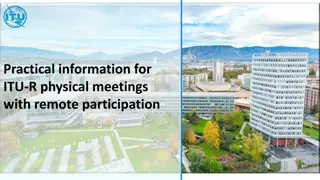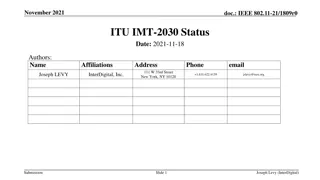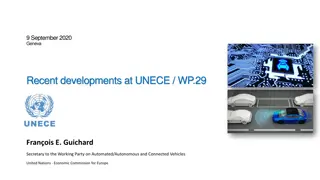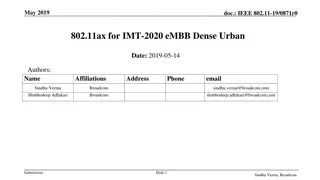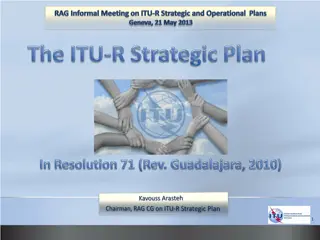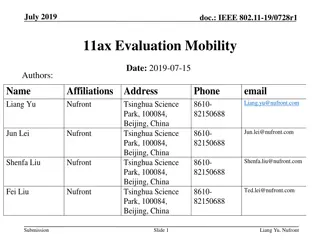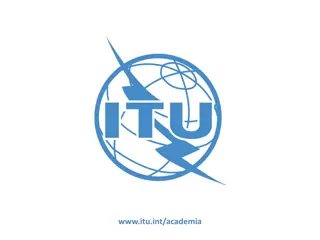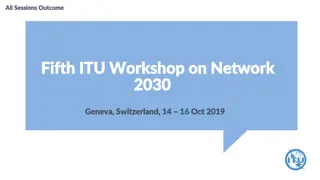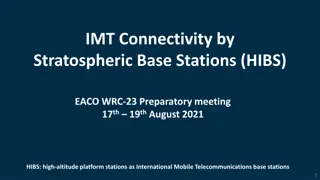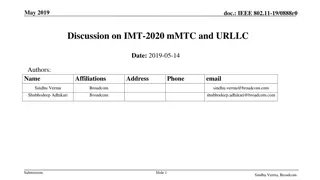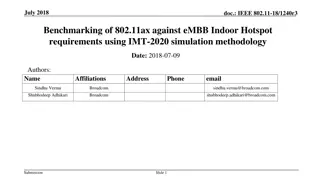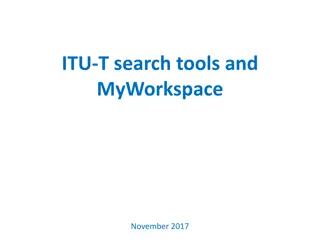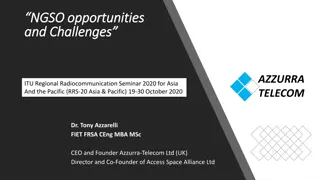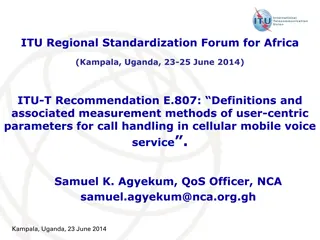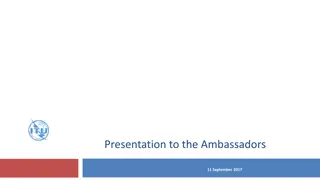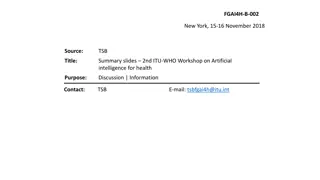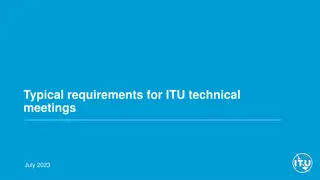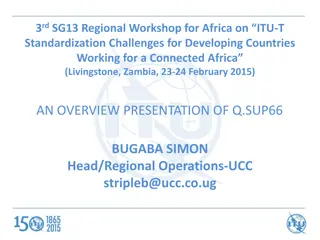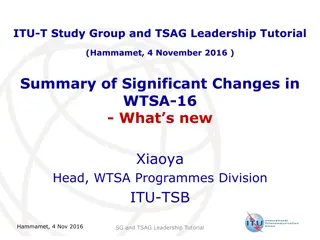Insights from ITU IMT-2020/5G Workshop in Geneva
The third annual ITU IMT-2020/5G Workshop in Geneva focused on activities and future plans in standardization for 5G networks. Key takeaways included the need for built-in security, flexibility in network setup, privacy controls, and AI/ML-based attack detection. Various ITU study groups are actively contributing to the IMT-2020/5G ecosystem by addressing security, network protocols, environmental requirements, and more.
Download Presentation

Please find below an Image/Link to download the presentation.
The content on the website is provided AS IS for your information and personal use only. It may not be sold, licensed, or shared on other websites without obtaining consent from the author.If you encounter any issues during the download, it is possible that the publisher has removed the file from their server.
You are allowed to download the files provided on this website for personal or commercial use, subject to the condition that they are used lawfully. All files are the property of their respective owners.
The content on the website is provided AS IS for your information and personal use only. It may not be sold, licensed, or shared on other websites without obtaining consent from the author.
E N D
Presentation Transcript
All Sessions Outcome All Sessions Outcome Third annual ITU IMT Third annual ITU IMT- -2020/5G Workshop and Demo Day Workshop and Demo Day 2018 2018 2020/5G Geneva, Switzerland, 18 July 2018 Geneva, Switzerland, 18 July 2018
Session 1: IMT Session 1: IMT- -2020/5G standardization (part 1): activities and future plan in 2020/5G standardization (part 1): activities and future plan in ITU ITU- -T SGs T SGs Takeaways and Conclusions Takeaways and Conclusions Suggestions to IMT Suggestions to IMT- -2020/5G Future directions for 5G security may include: Apply built-in security (security by design approach rather than bolt-in security one) Incorporate increased flexibility in security setup to meet requirement for a programmable, dynamic, and sliced 5G network Make secure key components in 5G, such as SDN/NFV/network slicing, since they provide key foundation for implementing a programmable 5G network Put privacy controls in place to comply with data protection regulations and contractual agreement with other organizations Consider a high level automation in security orchestration due to a highly dynamic 5G network . Adopt AI/ML based attack detection and mitigation needs to be adopted 2020/5G 1. ITU-T SG13 position in the IMT2020/5G ecosystem is to contributing with international harmonized Terms & Definitions as well as high level Frameworks, Principles and Requirements 2. As one of its missions ITU-T Study Group 13 works to include requirements and interests of the developing countries into the technical IMT2020/5G standardization 3. ITU-T SG13 has created new Focus Group on Machine Learning for Future Networks including 5G to studying potential application of ML based mechanisms in 5G Telecommunication Networks 4. ITU-T Study Group 13 s Joint Coordination Activity on IMT2020 (JCA-IMT2020) is the platform for contributions and information what work is done in all of the different groups dealing with IMT2020/ 5G 5.
Session 1: IMT Session 1: IMT- -2020/5G standardization (part 1): activities and future plan in 2020/5G standardization (part 1): activities and future plan in ITU ITU- -T SGs T SGs Takeaways and Conclusions Takeaways and Conclusions Suggestions to IMT Suggestions to IMT- -2020/5G 2020/5G 5. ITU-T SG15 focuses mainly on assessing the impact on transport network when supporting the 5G ecosystem (including management/control, ) Strategies for protocol development on IMT- 2020: Avoid unnecessary duplicated works with relevant groups via a close collaboration with ITU-T SG 13 and other SDOs, Forum, etc. and enhancing collaboration with Open Source Community for efficient evaluation of protocols Encourage members to submit new work item proposals on protocols for IMT-2020 network to resolve problems and to provide enhancement capacity, synchronization, 6. The major standardization activities by ITU-T SG17 on IMT-2020 include requirements and key components for implementing 5G security identifying threats, 7. The activities of ITU-T SG5 on IMT-2020 aim to set the environmental requirements for 5G, and studies are related to ectromagnetic electromagnetic fields, energy feeding & efficiency and resistibility compatibility , 8. ITU-T SG11 is dealing with signalling protocols and testing aspects of IMT-2020 through five different questions
Session 2: IMT Session 2: IMT- -2020/5G standardization (part 2): activities in other 2020/5G standardization (part 2): activities in other Groups Groups Takeaways and Conclusions Takeaways and Conclusions 1. Global collaboration and joint effort leads to success for IMT-2020 and 5G 2. ITU-R and industry partnerships remain strong and well aligned for IMT-2020 and 5G 3. Engagement by Administrations is high -both on spectrum and technology 4. ITU-R IMT-2020 vision continues as the global target in support of 5G 5. ITU-R IMT-2020 radio interface technology specifications Recommendation on track for year- end 2020 release 6. Planned early 5G deployments will expand to encompass the IMT-2020 vision as initial technology matures in capability and availability over next several years 7. ITU-R is well on schedule to implement all necessary procedures to identify the important future mm wave spectrum (WRC-19) within the IMT overall spectrum portfolio 8. IMT-2020 and 5G requires spectrum both below and above 6 GHz to support a rich portfolio of use cases.
Session 2: IMT Session 2: IMT- -2020/5G standardization (part 2): activities in other 2020/5G standardization (part 2): activities in other Groups Groups Takeaways and Conclusions Takeaways and Conclusions 9. ONAP Beijing is deployment ready focus on architecture, seven dimensions of deployment & functional enhancements 10. ONAP, along with other LF Networking projects, continues to drive Open Source Networking momentum & harmonization across industry 11. 3GPP has made rapid progress and has completed most aspects of 5G Phase 1 standardization 12. As work on the final aspects conclude, agreements have been achieved for the contents of 5G Phase 2, which will constitute the IMT-2020 submission. The overall project components, its progress and plans will be considered, as well as significant work with other standards organizations to achieve the goals of 3GPP s 5G standards program 13. Academic and industry members of WWRF are actively working in setting-up an ITU Evaluation Group; Performance evaluation of PHY and MAC through simulations is aimed at
Session 3: Industrys achievements on IMT Session 3: Industry s achievements on IMT- -2020/5G and potential future developments 2020/5G and potential future developments Takeaways and Conclusions Takeaways and Conclusions Suggestions to IMT Suggestions to IMT- -2020/5G 2020/5G 1. Many successful trials of 5G were performed by telecom operators with focus on different 5G use cases (such as virtual reality, connected cars, ) Different from traditional mobile service for public users, industry verticals have their customized requirement with service guarantee, which need deep cooperation between operators and verticals to explore key use cases and customers 2. 5G will offer important opportunities to mobile users, enabling new Lifestyle and new experience, will vitalize new industry by innovating network infrastructure and ecosystem 3. From technical aspects, 5G network slicing, one of key 5G features, is an end -to-end network technology which needs to be promoted from the aspects of standards, technologies and industries, while from business aspects, 5G network slice is a basic service or product for industry verticals. To design a network to support 5G, we had better design it for a lifespan going over 5G; so it is interesting to start, from now, studies related to the standardization of Networks in 2030 4. Current Internet cannot guarantee new application delivery constraints 5. Super Ultra-Low Latency (<1ms), guaranteed Latency and Precision Latency are key elements in Network 2030
Session 4: IMT Session 4: IMT- -2020/5G Demos and Proof of Concept (Part1) 2020/5G Demos and Proof of Concept (Part1) Takeaways and Conclusions Takeaways and Conclusions Suggestions to IMT Suggestions to IMT- -2020/5G 2020/5G 1. 5G has to seen as a programmable software network customizable for specific application needs 2. Application driven networking will gain momentum, network operators might loose control of the networks 3. The rise of Private Networks vs. Network Slicing as last resort 4. 5G Standardization will catalyze the integration of SDN, NFV, Edge Computing, IOT and push for plug&play networking software 5. Open Testbeds are key to enable the key industry verticals to understand 5G 6. 5G role out, migration and interworking with legacy LTE / NB-IOT Networks will be challenging Future directions may include: Edge computing based on host based networking ICN slice (edge processing at the network layer caching/aggregation) ICN service slice (mobility/contextual routing to service) In-network compute (NPU/GPU, dynamic compute allocation): including but not limited to NFN /NFaaS
Session 4: IMT Session 4: IMT- -2020/5G Demos and Proof of Concept (Part1) 2020/5G Demos and Proof of Concept (Part1) Takeaways and Conclusions Takeaways and Conclusions Suggestions to IMT Suggestions to IMT- -2020/5G 2020/5G 7. ICN makes lot of sense in the edge mainly by enabling seamless contextual networking platform to connect heterogeneous devices, applications with edge compute, cache and storage resources 8. Mosaic5G was formed to develop, promote, and share an ecosystem of open-source platforms and use-cases for 5G system R&D leveraging SDN, NFV, and MEC tech enablers 9. The 5GCHAMPION PROJECT is a consortium composed of 8 EU and 13 KR partners, and the 5G PoC at 2018 Winter Olympic Games enclosed 10 objectives including technical, standardization, dissemination ..., and 3 demonstrators (PoC at OG, satellite, and short- range indoor link)
Session 5 : IMT Session 5 : IMT- -2020/5G Demos and Proof of Concept (Part2): Live demos 2020/5G Demos and Proof of Concept (Part2): Live demos Takeaways and Conclusions Takeaways and Conclusions 1. IoT services delivered over ICN present many key benefits (self-configuration based on names without need for configuration protocols as in the case for IP address assignment, name based security and trust management useful during bootstrapping and data distribution phases, absence of any overhead for managing connection oriented stack on the constrained devices, simplicity of unified name based routing, ) 2. The presented DIP router was capable of supporting low latency communications with low jitter (<20us independent of no. of network nodes) and packet loss rate 3. The presented network slicing runtime system enabled the dynamic creation of slices with SLA support and provided an efficient and flexible resource allocation among the different slices based on per slice QoS. In addition, a novel plug & play E2E execution environment was offered to customize and control RAN/CN slices as per service requirements
Panel Discussion: Future Steps in Network Development including 5G and beyond Panel Discussion: Future Steps in Network Development including 5G and beyond Takeaways and Conclusions Takeaways and Conclusions Suggestions to IMT Suggestions to IMT- -2020/5G 2020/5G 1. Collaboration with 3GPP needs to be with done through participation Inputs from the community is very useful to continue work on some areas such as QoS modeling and APIs at 3GPP 2. Sharing information is not enough in collaboration; a follow up is needed; An opportunity of collaboration between ITU- T and ONAP is in the use of AI for network automation and operation 3. In collaboration between open source and SDOs, the role of open source could be to prove the innovative ideas by codes 3GPP was kindly invited to present a tutorial on IMT-2020 during the upcoming SG13 Regional Workshop for Africa 4. Coordination groups are advantageous to have efficient collaboration between SDOs and other groups on 5G


